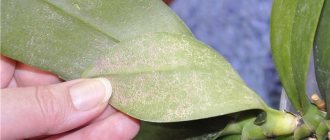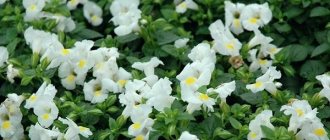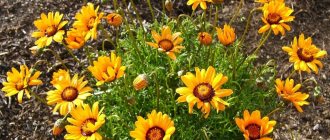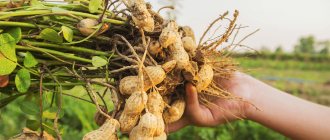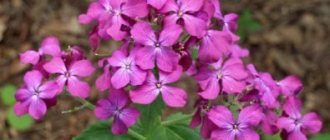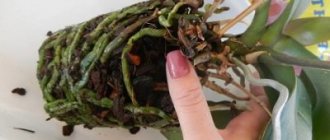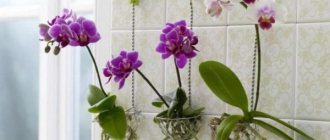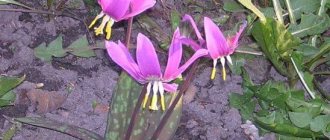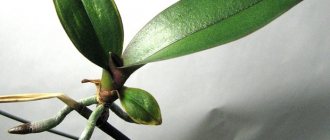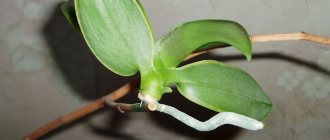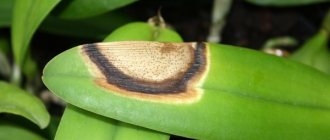Characteristics of Vietnamese orchids
Representatives of the Orchid family from the Paphiopedilum genus are widely represented in indoor floriculture. They belong to the Asian species, as they grow in the wild in Vietnam, India, China, Sumatra, and New Guinea. About 50 plant varieties are known, and dozens of hybrid forms have also been bred.
In Russia, exotic plants are sold in specialized stores; numerous tourists also bring orchid bulbs from Vietnam. Unlike the popular phalaenopsis, paphiopedilums require more careful care, but the results are impressive.
Magnificent orchids bloom on beautiful peduncles that look like a small shoe. It is no coincidence that when translated, the name of the flower genus sounds like Venus’s slipper (literally, the slipper from Paphos, the hometown of the goddess Venus). The genus has been known since the 19th century, at which time the very first hybrid forms of these orchids appeared.
Paphiopedilums are distinguished according to various characteristics:
- place of growth in the wild (epiphytes, lithophytes, aboveground);
- type of flowering (one or more flowers);
- leaf color.
Above-ground varieties are grown in apartments, since it is difficult to create the necessary conditions for epiphytes (those that grow on tree trunks).
On a note! Many people mistakenly classify orchid epiphytes as parasites. But in fact, they grow and are attached to other plants (phorophytes) only as a base, and do not receive nutrition from them.
Plants, depending on the variety, produce one or more flowers. The general flowering period is from 1 to 3 months. There are also revolving species in the family that produce flowers one at a time (up to 25-30 in total). For such plants, flowering times can last up to one and a half years, with 2-3 flowers opening at a time. Peduncles reach a length of 5 to 60 cm. The lower lateral sepals (petals) are often fused and hardly noticeable. Petals (upper lateral ones) are usually elongated, but there are species with round petals.
Among the features of Vietnamese orchid types:
- sympodiality (peduncle comes out of the rosette only once);
- the presence of a shortened underground stem - rhizome.
Different types of Paphiopedilum require different growing conditions:
- multi-flowered plants with variegated leaves thrive in warm conditions;
- multi-flowered, as well as species with green single-color leaves, grow best in partial shade.
All these features must be taken into account when planting and caring for luxurious flowers.
Description
Orchid is an asparagus-flowering plant of the orchid family (lat. Orchidaceae). The name of the flower was given by the ancient Greek philosopher Theophrastus based on the shape of the bulb; from the Greek “orhis” means “testicle”. There are many up to 30 thousand species of this ancient family, which appeared in the Late Cretaceous era. These plants are mainly perennial herbs, less often shrubs and woody vines.
The sizes of paphiopedilums, depending on the species, range from several centimeters to several meters. The shape of the flower is formed according to the following scheme: three sepals and three petals are alternately collected, one or two stamens are fused with the style of the pistil, the stigma of which is located inside under the anther. The most suitable for growing indoors are epiphytic and epilithic.
Note. Their root system is a spongy tissue of dead cells filled with air. During the rainy season, the roots absorb moisture well, so orchids with such reserves are not afraid of dry weather and can easily tolerate it.
These flowers grow in two types: ground and aerial. Aerial ones sprout in tree trunks, gracefully falling with leaves and branches. Delicate and fragile like porcelain, they are strikingly different from the bright, juicy ones on the ground. With fleshy, dense stems, they grow into the soil or rock crevices containing organic food.
You may be interested in:
How to identify negative factors and diseases of an orchid An orchid is resistant to diseases and pests. However, some ailments still damage...Read more...
Paphiopedilum species
In specialized flower shops, hybrid forms are most often presented; “pure” Venus’s slippers are rare. Hybrids are more resistant to disease, unpretentious and grow successfully indoors.
You may be interested in: How to care for orchids in a pot after purchase Why the leaves of an orchid wither and how to save it Features of the care and propagation of the Dendrobium Nobile orchid
Among the most famous:
- Bellatulum - with patterned leaves. Gives one flower (white or cream);
- Delenati - with a spherical “lip”, produces up to two flowers. Color – white, yellow, purple;
- Vietnamese - multi-colored, petals with a pocket. Flower diameter – 8-10 cm;
- Siamese - one flower, flowing shades (green, brown, purple);
- Pinocchio is a single-flowered species, the petals are white, with lilac-lilac stripes, strokes, and spots;
- America - an orchid with long strapped leaves, green-burgundy petals, white sepals. There are purple dots in the center;
- Black Jet - flowers with burgundy color (rare species);
- Maudi is a single-flowered plant, the color is light green with a lilac or burgundy tint.
The hybrid Elena, a plant with yellow flowers covered with a waxy coating, is distinguished by its long flowering, but the Appleton variety is famous for its very delicate aroma.
Characteristics and diversity
Vietnamese orchids are represented by several very graceful and diverse species. All of them belong to Paphiopedilum. Their differences relate to the sizes, shapes and colors of flowers.
- Paphiopedilum Vietnamese differs from the others in the unusual shape of the lower petal, which resembles a shoe.
- The violet-brown wide flower with a delicate aroma is a characteristic feature of Appleton's Paphiopedilum.
- On the peduncle of the Siamese Paphiopedilum, only one flower blooms, colored lilac-green with brown color.
- Up to 10 centimeters in diameter, with green veins and black speckles, are the flowers of the beautiful Paphiopedilum.
- One to two pleasant-smelling flowers on a short peduncle are Paphiopedilum uniflorum.
- Burgundy flowers with a light border with a peculiar leaf color, light green with dark spots - a distinctive feature of Paphiopedilum beardedum.
- Paphiopedilum Elena blooms for three months a year and blooms in shades of pale yellow.
Landing
Select medium-sized bulbs, without damage or spots. Buds or even a small sprout should be visible on the bulb, so the paphiopedilum will adapt faster and grow. The color of a healthy bulb is brown with a slight emerald tint.
Properly planting an orchid bulb brought from Vietnam means meeting deadlines and taking care of all the components in advance. You need to prepare the soil, the container where the orchid will grow and plant the flower as quickly as possible.
Substrate selection
For the “Vietnamese”, the substrate used for all orchids (for example, phalaenopsis) is suitable. Contains:
- peeled bark;
- peat;
- charcoal.
Proportions: 5:1:1. Perlite and dolomite flour (0.5 parts) are also added. Components such as sphagnum (forest moss), fern roots, and coconut chips have performed well. Perlite is replaced with expanded clay. To ensure that the substrate is saturated with air, all components are thoroughly mixed.
On a note!
Regular soil is not suitable for growing paphiopedilums.
Based on acidity indicators, neutral pH is selected. Among Paphiopedilums there are calciophiles - lovers of high calcium content in the substrate. This is due to the characteristics of the growth of orchids in the wild. For such plants, dolomite or chalk is added to the nutrient substrate mixture. It is necessary to control the pH level for such species, when acidifying, water with a solution of wood ash or change.
Selection of pots
It is easier to grow Vietnamese orchids in plastic transparent pots (buckets). The diameter of the container and transparency are taken into account. Through the transparent walls of the bucket it is convenient to observe the growth of the root system of the bulb, monitor the condition of the plant, humidity and the condition of the substrate.
To begin with, select small pots so that the onion freely produces roots, but is not “lost” in the substrate. For subsequent replantings, take a slightly larger container, taking into account the growth and development reserve of the plant.
Holes are made in the bottom of the pot to allow excess moisture to escape and air to pass through. When caring for orchids, it is important to prevent stagnation of water in the substrate and to ensure comfortable air exchange for the root system.
How to choose the right orchid bulb
Before purchasing bulbs from the market in Vietnam, you need to inspect them carefully. Dishonest sellers often try to sell worthless goods to tourists. Therefore, you need to trust only your own eyes, and not the laudatory speeches of traders.
Good onions should be fresh and firm. There is no need to buy bulba that is too light and dry. It is worth choosing medium-sized bulbs. Too small ones will take a long time to develop, and when growing large ones, the likelihood that they will disappear greatly increases. The color of good bulbs is brown with a slight greenish tint. If the bulb has been stored according to all the rules, its tip will be a little dry.
On a note! You definitely need to buy a bulb with a small sprout or bud. You can get a strong plant from it very quickly.
After purchase, the bulb is packaged in a dark plastic bag. The orchid is taken home in it. During transportation, periodically open the bag so that the bulb does not overheat and lose its viability.
Paphiopedilum care
Exotic flowers require special care, but there are no difficulties in it. It is important to follow the rules and take into account the characteristics of a particular type of paphiopedilum. In terms of specifics, care is similar to Saintpaulias, but there are some nuances.
Temperature
Variegated paphiopedilums grow in good light (but exclude direct sunlight), but plants with green leaves (usually single-flowered) are better suited to partial shade.
It is advisable for representatives of green-leaved plants to withstand temperatures from +10ºC to +25ºC (in the warm season), in winter from +10ºC to +13ºC. “Slippers” with variegated leaf blades grow in warm conditions, temperature range +20ºC...+30ºC combined with high humidity. During the cold period, for such plants the indicators are reduced to +18ºC. Lowering is necessary, as it promotes the formation of flower buds.
Watering
Note!
The watering schedule for Paphiopedilums differs from other orchids because they do not have pseudobulbs, powerful leaf blades where plants usually store moisture. The substrate is kept moist at all times, but without excess water.
The root system of lady's slippers should not dry out, otherwise the plant will stop growing. At the same time, excess moisture in the substrate soil leads to rot of the tubers and the occurrence of diseases. The irrigation regime depends on the age and size of the plant and the type of substrate.
Use filtered clean water, otherwise the leaves of the orchids fade and the rosettes turn yellow. Irrigation with clean rain or melt water is allowed.
Approximate schedule:
- in winter – once 7-10 days;
- in summer - from 2 to 5 times a week.
In hot weather, water more often; in cool weather, reduce irrigation and be sure to monitor the condition of the plants and soil. The time for watering is morning, since during the day the substrate will absorb moisture, and drops of water will dry on the leaves of the plant.
If moisture suddenly gets into the center of the socket, then carefully dry it with a napkin. It is undesirable for water to get on the orchid, as this increases the risk of various infections.
In the first months after planting and the appearance of sprouts, the orchid is watered, wetting the surface of the soil. Later, for adult plants, immersion of the container in water for 20-30 minutes, as well as sprinkling, is used. After immersing the pot, the flower is placed on a wire rack to drain excess water from the substrate.
Care during flowering
Lady's slippers produce a flower stalk in late autumn or early winter. In the very center of the rosette, a signal leaf appears - a peduncle, which soon produces a bud. During the flowering period, the plant cannot be rearranged or the container rotated. Complete rest, regular careful watering and fertilizing with phosphorus-potassium compounds are required.
After flowering, slightly lower the temperature, eliminate fertilizers, and reduce watering. They return to normal care after new sprouts appear on the bulbous rosette.
Feeding
Paphiopedilums do not store nutrients and moisture for future use; they need to be fed often. Typically, fertilizers are applied with irrigation, adding fertilizing after 4-5 waterings.
Feed in the summer; in winter, the plant does not require additional nutrition. Complex formulations with the formula NPK 4:6:6 (increased content of phosphorus and potassium), as well as fertilizers with the same proportions of components, are suitable. Complexes for increasing the green mass of plants provide a higher nitrogen content: 4:3:3.
On a note!
Excess of any fertilizer is detrimental to orchids.
Special formulations for orchids are available for sale. The dosage indicated in the instructions for paphiopedilum is reduced by half. Florists use:
- Kemira Lux (for orchids);
- Cameleon;
- BonaForte and others.
To avoid salinization of the substrate, it is washed in filtered water. The timing is approximately once every 30-40 days, the excess liquid is completely drained.
Diseased plants are not fed, as the infection must first be eliminated. Any compositions are applied to a pre-moistened substrate; dry fertilizers are not used for paphiopedilum.
Lighting
Orchids are photophilous, but tolerate scattered rays of the sun better. During the period of plant growth and formation, they are provided with a long daylight period and a short night period (5-6 hours). In an apartment in winter, it is advisable to organize additional lighting (up to 13-15 hours a day).
The ideal places for paphiopedilum are eastern windows, where they practically do not need to be shaded. On southern and western window sills it is imperative to install protection from aggressive UV rays. A signal that the lighting is too strong is the redness of the orchid’s leaf blades.
Orchid at home and in the garden
An orchid is a flower with an original shape and a bizarre color of the corollas. Belongs to the Orchidaceae family and has many species.
Plato's student Theophrastus discovered for the first time in the natural environment a plant with a root system in the form of a pair of bulbs and named it “orchis” - translated as “testicle”.
Orchids are mainly herbaceous plants; shrubs and woody vines are less common. Some representatives lead an epiphytic way of life: they grow on other plants, but are not parasites, but use them as support. There are lithophytes - orchids growing on rocks and rocks.
How to propagate paphiopedilums
Common ways to increase the quantity of an exotic plant are to propagate it by seeds or by dividing rosettes. The meristem option (using plant tissue) is not used with Vietnamese orchids. Seed propagation is used by breeders, since it is quite long-lasting, but planting in divisions is more suitable for the home.
Each segment must have at least 2 sockets. You should not buy divisions with one rosette; such orchids take a long time to take root and do not bloom for even longer. In addition, such plants have very little chance of survival, and often the purchase results in a financial drain.
Only powerful plants that have a large number of rosettes are divided. If their number is small, dividing paphiopedilums is ineffective.
Action plan:
- dissection of the rhizome and separation of rosettes (2-3 each) per division;
- planting in a substrate of moistened (but not damp) moss;
- covering the divisions with a glass container to create an optimal humidity regime.
On a note!
The jar is regularly removed to ventilate rooting plants.
You can do it differently: place the cuttings along with the moss inside a large glass jar. Then there will be the necessary humidity near the plants, and ventilation occurs in the usual way.
As soon as the roots reach 4-5 cm, the division is carefully transplanted into a regular substrate with the addition of bark, chips, and perlite. Further care is the same as for adult bushes, but without fertilizers. When feeding, the root system develops worse, so you need to give it time for normal growth and formation.
Where, how and for how much can I buy?
The online store orchidee.su offers to purchase various types of orchids at a price of 900 rubles , delivery costs depend on the region. While in Vietnam, in Vung Tao, you can safely go to any flower shop to buy Vietnamese orchid bulbs, of which there are a lot.
You can also buy them at flower markets (for example, in Dalat or Ho Chi Minh City), where the largest number of orchid species are found. The lowest prices for plants are found at the Cho Dam market in Nha Trang.
Possible problems
Paphiopedilums are considered finicky to care for, although if you provide a comfortable watering regime and temperature, they will delight you with long-term flowering. What difficulties arise when caring for exotic flowers and how to avoid them and correct problems:
- Wilting leaves are a sign of rot on the roots of the plant. Urgently transplant the bush into a new substrate and pot, carefully removing all rotten areas with a sterile knife.
- Do dry local spots appear on the leaves? The orchid receives too much sunlight, it is recommended to shade the flower.
- The plant produces new leaves, but they are smaller in size than the old ones. It is necessary to feed the paphiopedilum with a nitrogen supplement and slightly lower the temperature.
- The lack of flowering is caused by various reasons. Most often it is a lack of lighting or improper watering.
- There is no reason to worry when the lower leaf blades of a flower fall off. This is a natural process as the plant forms and matures.
- The dropping of flowers and the appearance of slimy spots on the leaves are symptoms of a dangerous disease of bacterial rot. The infection starts from the base of the leaf along the central vein. The boundaries of healthy and diseased tissue are clearly visible. It is necessary to isolate the plant from others, cut off damaged areas, treat the sections with iodine and a solution of brilliant green. Spraying with Bordeaux mixture helps, but only in very small quantities. Copper clogs the pores on the leaves, making it more difficult for the plant to breathe.
- The appearance of signs of bacterial rot (spots, mucus) near the base of the stem is a signal to remove the orchid from the container with the substrate. The plant is processed as described above, then kept for about 2-3 weeks with open roots in a bright place (for example, in a glass jar). Humidity – 50-55%, and regularly, throughout the quarantine period, immerse the roots in water (for a couple of minutes). Planting in the substrate is possible only after the flower is completely cured.
- To protect Vietnamese orchids from pests, the preparations Tanrek, Fitoverm, Aktara are used. Compositions according to folk recipes help: infusions of onion peels, tobacco, soap solution. To get rid of midges, use cloves of garlic or lemon peels; to get rid of spider mites, wipe the leaves with Fitoverm solution and carefully spill the substrate.
Transfer
Orchids do not tolerate pot changes well. Therefore, they are replanted only as a last resort, when the plant is sick and needs to change the substrate, or if the previous container has become too cramped for it. Planned transplantation is carried out in the spring months, when the rapid growth phase is underway.
The new container is chosen so that its diameter is 2-3 cm larger than the previous one. To avoid harm to the root system, before removing the plant from the previous container, it is watered abundantly. The roots of the extracted specimen are cleaned of pieces of waste substrate, washed and inspected. All roots with signs of spoilage are cut off, including healthy tissue. The cut areas are sprinkled with ground cinnamon or activated carbon for disinfection.
Important!
Before placing the flower in a new box, leave it for 8 hours without covering so that the roots dry out.
Drainage material and disinfected substrate are placed in a new container, as during planting. The flower is placed with the root collar above the ground level, but without raising it above the edge of the pot. Aerial roots do not go deep. After planting, do not compact the soil, and do not water the flower for 5 days.
Reviews
Vasilisa, Omsk
I grow different types of orchids, including paphiopedilums. I bought it at a discount and waited 2 years for the color. The beauties have bloomed and now produce buds (single-flowered) every autumn. There are also a couple of revolvers, very unpretentious. They bloom in early spring and gradually produce flowers until the end of summer. They stand in partial shade (they like it there better) and do not require any special attention.
Tatyana, Moscow
I really like variegated varieties, as they are easier to care for and bloom faster for me. It didn’t work out very well with the green-leaved ones. I grow it as usual: I constantly moisten the substrate and feed it about once a month. Caring for an orchid is not difficult. Now just one orchid is producing a flower stalk, the buds are constantly turning towards the light. They bloom beautifully, these orchids look like some kind of alien creatures.
Paphiopedilums are orchids from Vietnam that are especially loved by gardeners. If you follow the rules, it is not difficult to grow an adult plant from a bulb and wait for the orchid to bloom luxuriously even at home.
Feeding
The substrate for epiphytes contains almost no nutrients. Therefore, they are constantly supplied with nutrients, at least once a month. During the period of rapid growth and flowering, nutrients are added every two weeks. Special mixtures for epiphytes are used as fertilizer, but the dosage recommended in the instructions is halved.
When the flowering time is over and the orchid sheds its buds, fertilization is stopped. They are also abandoned in winter, when the orchid goes into a dormant state. Often the soil of epiphytic plants becomes salty. To correct this deficiency, water the flower with distilled water. Then, during the next irrigation, nutrients are added to the water.
Propagation of orchids by cuttings
In order to propagate an orchid by cuttings, you need to know for which species this method is suitable. Oddly enough, both sympodial and monopodial species can be propagated by cuttings. In the first case, cuttings will be carried out with a pseudobulb, and in the second - with peduncles.
The best results of this type of propagation are produced by dendrobiums and phalaenopsis. However, there are also negative experiences, since the result depends on many factors: environment, lighting, and most importantly, the genetic characteristics of the orchid. Experienced gardeners also do not recommend using cymbidiums, cattleyas and other more expensive species for this.
So what should you do to propagate from cuttings?
- We will need a peduncle or pseudobulb. The peduncle can be cut off after it begins to dry out, and the pseudobulb can be taken from any faded dendrobium.
- We will need a mixture of fine bark and sphagnum moss.
- Sections of peduncles can be dried, sections of pseudobulbs can be treated with phytosporin or filled with paraffin.
- We place the prepared substrate in a greenhouse and place the cuttings there.
- As the substrate dries, it should be moistened with a spray bottle. The temperature should be maintained at 23-25 degrees, there should also be diffused light and regular ventilation.
The first results can be seen within 1-2 weeks. Dormant buds may awaken on the peduncles of phalaenopsis, and new shoots may appear on the pseudobulbs of dendrobium, which will eventually become babies.
Transplantation
Orchids need to be replanted frequently, because the substrate quickly deteriorates, it becomes too dense, and its acidity changes. So flowers growing on sphagnum are replanted every two years, on bark every three years. Sometimes you have to do this more often if pests appear, if the substrate clearly begins to deteriorate (which can be indicated by an unpleasant odor), if improper watering has led to rotting of the roots. The best time for this is spring, when the flower grows most actively.
For transplantation, take new transparent dishes of a slightly larger size and a new substrate. In the same way, stones and a drainage layer are placed on the bottom, then the substrate itself is placed. The flower is watered abundantly so that it can be removed without causing the slightest harm. Sometimes you have to sacrifice an old pot; it is broken or cut if the substrate has become so compacted that even after watering it is not possible to remove the plant. The roots of the plant are placed in warm water to completely free it from the old substrate.
If there are damaged or rotten roots or leaves, they should be carefully cut off and the cut areas should be sprinkled with crushed coal.
The plant is placed in a new pot, the substrate is added, lightly tapping the pot so that it is better distributed. After planting, water the plant; if moisture gets on the growing point, it is better to get it wet. The root collar should be above the substrate, a centimeter below the edge of the pot.
Features of planting an orchid in a pot
How to properly plant an orchid in a pot? First of all, you need to choose a pot. Plastic or special ceramic orchid pots with side drainage holes and coated with glaze on the inside are well suited for planting.
In ordinary clay pots, the roots of the plant can stick to the walls and are severely damaged during replanting.
In a plastic pot, you need to make quite a lot of holes in the bottom and walls. Drainage must be laid at the bottom. The volume of the pot should not be very large. In front of the false bulbs, space is left for the appearance of 2-3 new growths. After planting, the space around the plant is covered with moss.
Features of planting an orchid in a pot are shown in the video:
Is it necessary to plant an orchid in a transparent pot?
It is necessary to plant epiphytic plants whose roots participate in the process of photosynthesis, for example, phalaenopsis, in a transparent pot. You can use glass or translucent plastic pots.
Glass pots are not suitable for ground orchids; the roots in them will not have enough air. It is good to use transparent plastic pots to see the root system and distribute fertilizer and watering correctly.
Reproduction of orchids by children
This method is most relevant for the most common orchids of the phalaenopsis species.
It is these plants that reproduce very readily even without additional intervention from the grower. Reproduction of orchids at home with the help of children can be provoked by hormonal pastes containing cytokinins. However, children often appear in the roots and on the trunk of the plant itself. This paste contains phytohormones - cytokinins, which accelerate the plant's metabolism and enhance the growth of new shoots and buds. However, it should only be used on healthy and mature plants.
The natural appearance of babies in orchids is possible immediately after flowering. The upper or middle bud on the peduncle awakens and produces either new growth or a new shoot. Read on to learn how to propagate orchids using paste.
Baby on a peduncle
In order to get a baby on a peduncle, you can use cytokinin paste. The action plan will be as follows:
- Using a sterile instrument, it is necessary to bend back the scales covering the dormant bud.
- Use a heated needle or clean toothpick to scratch the plant tissue next to it.
- Apply the paste to the dormant bud in a volume the size of a pinhead.
- The awakening of the kidney can be observed on days 7-10.
Propagation using orchid paste can result in the formation of 2-3 new shoots from one bud. Such mutations are very harmful to the aesthetic appearance and lead to severe stress on the mother plant. This can happen both due to an overdose of hormonal paste, and due to genetic pathologies in development. It is difficult to say how strong or weak the baby will be, but, according to numerous reviews from flower growers, the offspring after cytokinin paste are an order of magnitude weaker, and the flowering is not as lush as that of the mother.
Another important point when propagating orchids by children is the need for proper rooting of the child. Quite often, young growths are in no hurry to build up the root system, but they push out new leaves one after another and may even bloom. This situation has a negative impact on the mother; she may not have enough strength to feed the baby.
A good way to quickly grow roots in young plants is to create a cushion of moss or so-called planting in a pot directly on the mother’s peduncle. For this we need:
- A small pot with a diameter of 2.5 cm or a cut plastic bottle of 0.5 liters.
- Scissors.
- Scotch.
- Sphagnum moss.
- Pin.
At the bottom of the pot we make a hole for the diameter of the peduncle. Using scissors, we cut the pot vertically down to the hole and wrap the pot around the peduncle so that the baby is ¾ of the way up to the pot. Secure the container from below with a clothespin. We glue the walls of the pot together with tape and put sphagnum moss inside, after moistening it with water and a rooting agent. A good drug for this is Kornevin - it is accessible and inexpensive.
This method adapts young plants well to independent life, and the undoubted advantage is that the orchid immediately learns to feed on roots, which reduces stress during transplantation. Among other things, flower growers note a positive point in the fact that the roots immediately grow inside the pot and the transplant will be less traumatic.
Root baby
Basal children, or as they are also called, basal, can appear in monopodial orchid species. Most often they begin to grow in phalaenopsis, but it is impossible to induce an orchid to this type of reproduction. As a rule, a basal baby appears when the mother plant is in danger and the plant does not want to interrupt its life cycle.
Experienced gardeners categorically do not recommend smearing the trunk of healthy phalaenopsis with cytokinin paste - this method can be detrimental to the plant.
Photo
Next, you can see a photo of what the seeds look like and what grew from them:
Care
After a few weeks or months, changes begin to occur in the crops. Green balls appear on them, then the first leaves. After two or three leaves appear, roots begin to appear. Only after a year can the seedlings be transplanted into a pot. To fill the pot, a suitable substrate of moss, fern roots and pine bark is suitable.
The soil should be as fine as possible. The sprouts are removed from the flask as carefully as possible with tongs, washed in water and transplanted into a substrate, which is first poured with boiling water for 30 minutes. Plants need light and high humidity all the time.
